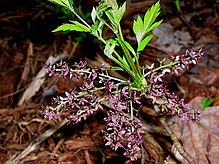Xanthorhiza
| Yellowroot | |
|---|---|

| |
| Yellowroot flowers in spring | |
| Scientific classification | |
| Kingdom: | Plantae |
| Clade: | Tracheophytes |
| Clade: | Angiosperms |
| Clade: | Eudicots |
| Order: | Ranunculales |
| Family: | Ranunculaceae |
| Subfamily: | Coptidoideae |
| Genus: | Xanthorhiza Marshall |
| Species: | X. simplicissima
|
| Binomial name | |
| Xanthorhiza simplicissima Marshall
| |
| Synonyms | |
|
Xanthorhiza apiifolia L'Hér. | |
Xanthorhiza simplicissima (yellowroot) is the only member of the genus Xanthorhiza, and one of very few genera in the family Ranunculaceae with a woody stem (the other notable example being Clematis). It is native to the eastern United States from Maine south to northern Florida and west to Ohio and eastern Texas. It contains the alkaloid berberine, which has a number of traditional and contemporary uses for dyeing and medicine.
The genus name as well as the common name refer to the plant's yellow roots (xantho- meaning "yellow" and rhiza meaning "root"), which was used to produce a yellow dye by Native Americans. The species name refers to the simple (not branched) root.
In the wild, it grows on the edges of streams in sandy soil under a canopy of dappled sunlight. In cultivation, it is often provided with more sunlight so that the fall colors are more vivid. It is a subshrub, reaching 20–70 centimetres (8–28 in) (rarely 90 centimetres (35 in)) in height, with stems up to 6 millimetres (0.24 in) diameter. The leaves are spirally arranged, 10–18 centimetres (4–7 in) long, each divided into 5 toothed leaflets, and flowers emerge only from the upper portion of the unbranched stem. The flowers are produced in broad panicles 6–20 centimetres (2–8 in) long, each flower small, star-shaped, reddish brown to purple brown, with five petals.
Yellowroot propagates asexually by sending out many underground runners, and it reproduces sexually with seeds.
Yellowroot is comparatively rare in British gardens, although E.H. Wilson and E.A. Bowles are among distinguished plantsmen to have championed its merits. It was grown by Bowles in his garden at Myddelton House, near Enfield, Middlesex, and gardens that currently cultivate it include the Savill Garden at Windsor, Berkshire and the Westonbirt Arboretum near Tetbury, Gloucestershire.[1] Wilson, who regarded yellowroot as one of the best plants for hardy deciduous ground cover, also described (in 1923) its use in the Arnold Arboretum at Harvard University in Massachusetts.[2]
Yellowroot is considered an endangered species in Florida.
-
Closeup of yellowroot's flowers
References and external links
- Indepth Article in the Arnold Arboretum's Silva by Jill Nooney.
- Flora of North America: Xanthorhiza simplicissima
- Description with a picture of the fall colors
- site with a picture of the root
- Medicinal uses
- Foster, S. & Duke, J. A. (1998). Field Guide to Medicinal Plants: Eastern and Central North America. Houghton Mifflin. ISBN 0-395-92066-3.


